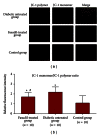The protective effect of fasudil on the structure and function of cardiac mitochondria from rats with type 2 diabetes induced by streptozotocin with a high-fat diet is mediated by the attenuation of oxidative stress
- PMID: 23762845
- PMCID: PMC3674652
- DOI: 10.1155/2013/430791
The protective effect of fasudil on the structure and function of cardiac mitochondria from rats with type 2 diabetes induced by streptozotocin with a high-fat diet is mediated by the attenuation of oxidative stress
Abstract
Dysfunction of cardiac mitochondria appears to play a substantial role in cardiomyopathy or myocardial dysfunction and is a promising therapeutic target for many cardiovascular diseases. We investigated the effect of the Rho/Rho-associated protein kinase (ROCK) inhibitor fasudil on cardiac mitochondria from rats in which diabetes was induced by a combination of streptozotocin (STZ) and a sustained high-fat diet. Eight weeks after diabetes was induced by a single intraperitoneal injection of 50 mg/kg STZ followed by a sustained high-fat diet, either fasudil (5 mg/kg bid) or equivalent volumes of saline (control) were administered over four weeks. Fasudil significantly protected against the histopathologic changes of cardiac mitochondria in diabetic rats. Fasudil significantly reduced the abundances of the Rho A, ROCK 1, and ROCK 2 proteins, restored the activities of succinate dehydrogenase (SDH) and monoamine oxidase (MAO) in cardiac mitochondria, inhibited the opening of the mitochondrial permeability transition pore, and decreased the total antioxidant capacity, as well as levels of malonyldialdehyde, hydroxy radical, reduced glutathione, and superoxide dismutase in heart. Fasudil improved the structures of cardiac mitochondria and increased both SDH and MAO activities in cardiac mitochondria. These beneficial effects may be associated with the attenuation of oxidative stress caused by fasudil treatment.
Figures




References
-
- McBride HM, Neuspiel M, Wasiak S. Mitochondria: more than just a powerhouse. Current Biology. 2006;16(14):R551–R560. - PubMed
-
- Lesnefsky EJ, Moghaddas S, Tandler B, Kerner J, Hoppel CL. Mitochondrial dysfunction in cardiac disease: ischemia—reperfusion, aging, and heart failure. Journal of Molecular and Cellular Cardiology. 2001;33(6):1065–1089. - PubMed
-
- Shen GX. Mitochondrial dysfunction, oxidative stress and diabetic cardiovascular disorders. Cardiovascular & Hematological Disorders—Drug Targets. 2012;12(2):106–112. - PubMed
-
- Shen GX. Oxidative stress and diabetic cardiovascular disorders: roles of mitochondria and NADPH oxidase. Canadian Journal of Physiology and Pharmacology. 2010;88(3):241–248. - PubMed
Publication types
MeSH terms
Substances
LinkOut - more resources
Full Text Sources
Other Literature Sources
Medical

